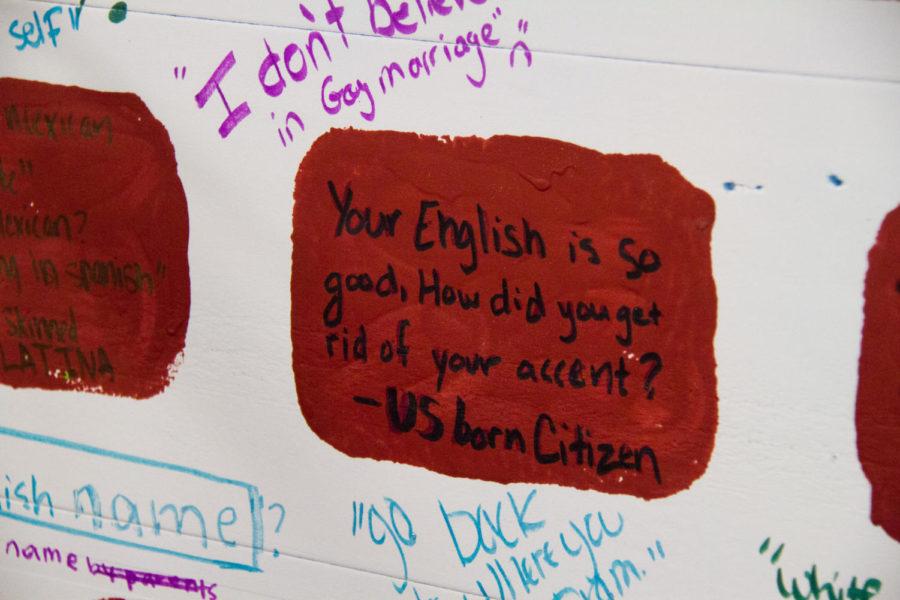Shaw: There is no such thing as a harmless stereotype
A statement from a student is written on the Hate Wall, created by the Asian Pacific American Awareness Coalition (APAAC) to let students and community members talk about various stereotypes they have encountered in their lifetime.
July 22, 2018
Stereotyping has a pervasive influence on the way people live their lives.
Stereotyping is unrealistic. Human beings are all unique individuals regardless of race, gender, religion, sexuality or any other identity or label.
Every person is inherently different, from the genetic makeup that defines physical appearances to the psychological development of people’s mindsets influenced by different upbringings.
Some argue that stereotypes often stem from some sort of truth. However, the idea of applying any truth based on observation of one individual or a small population to an entire demographic is absurd and insensitive.
I’m not here to say that people should stop stereotyping other people and that I have never stereotyped other people before in my life. Stereotyping, like many things, is very complex. If it is oversimplified then we cannot devise a complete solution.
The reality is that stereotyping is human nature.
“We categorize people automatically, unconsciously, immediately, based on a person’s race and based on a person’s sex,” said John Dovidio, a psychology professor at the University of Connecticut in an interview with ABC News. “When you’re a social animal, you need to be able to distinguish who’s a friend and who’s a foe. You need to understand who’s a member of your pack, who’s a member of a different pack.”
We are far more sophisticated than many other social animals. We are living in a far more developed world, where many different demographics are constantly interacting with each other in day to day life.
We must be more careful about stereotyping others. What may appear to be a harmless stereotype on its surface could turn out to be extremely harmful.
For example, some people consider Asian Americans to be model minorities due to racial stereotypes of them being smart, successful and motivated. However, considering how diverse the Asian American demographic is, this can’t possibly be true for every one of them.
The 2006-2010 American Community Survey 5-Year Estimates conducted by the U.S. Census Bureau found that 11.17 percent of Asian Americans were in poverty and 25.96 percent had low income. Additionally, among demographics considered Asian American, the Bhutanese population group had far higher percentages with 64.93 percent in poverty and 84.41 percent of people with low income.
This survey illustrates the disparity between the overall image and statistics of Asian Americans as a whole, along with differences between specific demographics within the Asian American population. Not all Asian Americans are the same and it is insensitive to assume that an entire population fits an image.
Model minority labels are particularly problematic where they place emphasis on expectations. The University of Texas at Austin Counseling and Mental Health Center even has a page dedicated to students struggling with harmful effects brought on by the model minority stereotype for Asian Americans.
Moreover, the purpose of the model minority argument itself is unethical. A National Public Radio article, “‘Model Minority’ Myth Again Used As A Racial Wedge Between Asians And Blacks,” discusses how the model minority stereotype was perpetuated to use historically selective immigration policies that have helped with creating the image of successful Asian Americans against other minorities to degrade them.
An interesting solution to some issues of stereotypes and labels is brought up by Morgan Freeman in a 2005 “60 Minutes” interview with Mike Wallace.
“Stop talking about it.” Freeman tells Wallace. “I’m going to stop calling you a white man, and I’m going to ask you to stop calling me a black man. I know you as Mike Wallace. You know me as Morgan Freeman.”
Freeman is bringing up a flaw in the way many people address other people by using easily identifiable labels. He advocates thinking of people as individuals rather than through labels such as white or black.
I understand how it is nearly impossible to eradicate stereotyping. However, I urge you to put in the effort to understand and think of people as individuals, instead of putting a label on them and assuming they are another part of a stereotypical image.







